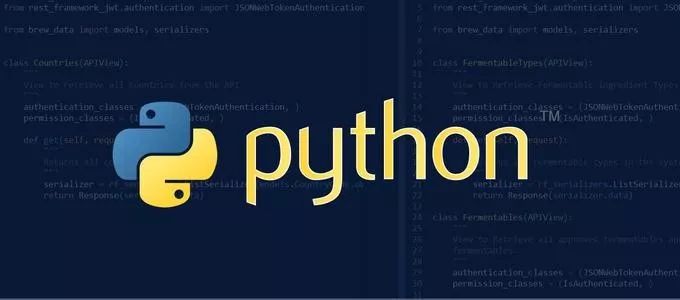
文 |?李晓飞
来源:Python 技术「ID: pythonall」

人生苦短,我用 Python!,这句话是激励无数人,踏上了 Python 的伟大征程的座右铭。
但是,Python 中的时间处理,搞得我怀疑人生,总是弄不清该用 time 还是 datetime,什么时间戳、时间运算、各种格式的时间转化,概念多,操作复杂,bug 还得找半天,实在是太麻烦了,一遇到时间处理就焦虑~
今天给大家介绍一个处理时间的神器 —— Pendulum[1],跟过去说拜拜,让你用 Python 处理时间快步如飞,还等啥,来吧!
神器亮相
Python 中神器亮相的姿势都差不多,有种熟悉的味道:
pip?install?pendulum顺利安装后,展示一下:
import?pendulum
d1?=?pendulum.yesterday()??#?昨天
#?2021-10-02T00:00:00+08:00
d2?=?pendulum.today()?#?今天
#?2021-10-03T00:00:00+08:00
d3?=?pendulum.tomorrow()?#?明天
#?2021-10-04T00:00:00+08:00
d2.diff(d1).in_days()?#?相差多少天
#?1
d2.diff(d1).in_hours()?#?相差多少小时
#?24
pendulum.now()?#?现在的时间是不是感觉很有亲和力,各种操作都符合人性化。
而且将 datetime 和 time 两个库合并了,再也不用纠结应该用哪个了。
下面浏览一下 Pendulum 的更大威力吧。
搞定时区
时区处理是比较麻烦地事情,还好我们只使用一个时区,省去了很多麻烦。
不过时区的概念需要了解,再说,谁能说得准,不开发国际化程序呢。
一起困难,Pendulum 让我们优雅处之。
看例子:
import?pendulum
dt1?=?pendulum.datetime(2021,?10,?3)
print(dt2.timezone.name)?#?UTC
dt2?=?pendulum.datetime(2021,?10,?3,?tz="Asia/Shanghai")
print(dt2.timezone.name)?#?Asia/Shanghai不指定,就是默认的 UTC 0 时区
创建时间对象时可以指定时区,例如我们的时区名称是
Asia/Shanghai通过
timezone.name属性,可查看时间对象的具体时区,或者直接用timezone_name直接获取,另外,属性timezone可以简写成tz
时区名称可在这里查:时区名称[2]
Pendulum 时区只支持用 时区名称 设置时区
时区运算
不同时区的时间可以用来比较、运算和转化,例如:
import?pendulum
first?=?pendulum.datetime(2012,?9,?5,?23,?26,?11,?0,?tz='America/Toronto')
second?=?pendulum.datetime(2012,?9,?5,?20,?26,?11,?0,?tz='America/Vancouver')
first.to_datetime_string()
#?2012-09-05?23:26:11
first.timezone_name
#?America/Toronto
second.to_datetime_string()
#?2012-09-05?20:26:11
second.timezone_name
#?America/Vancouver
first?==?second
#?True
first?!=?second
#?False
first?>?second
#?False
first?<?second
#?False
first?=?first.on(2012,?1,?1).at(0,?0,?0)
second?=?second.on(2012,?1,?1).at(0,?0,?0)
#?tz?is?still?America/Vancouver?for?second
first?==?second
#?False
first?!=?second
#?True
first?>?second
#?False
first?<?second
#?True
second.diff(first).in_hours()
#?3时区
America/Toronto和America/Vancouver相差 3 小时设置相差 3 小时的时间,两者是相等的
设置完全相同的时间,比较时是不相等的,计算它们之间的差异,可以看到相差 3 小时
diff方法用于与另一个时间对象比较,in_hours方法是时间区间的方法,可以将区间转化为小时,同理还有in_days、in_years等
时区切换
切换时区很方便,只要调用时间对象的 in_timezone 或者 缩写形式 in_tz 传入参数 时区名称 就可以了:
import?pendulum
in_perk?=?pendulum.now()
in_perk
#?DateTime(2021,?10,?4,?12,?10,?59,?986047,?tzinfo=Timezone('Asia/Shanghai'))
in_perk.in_timezone("America/New_York")
#?DateTime(2021,?10,?4,?0,?7,?50,?106336,?tzinfo=Timezone('America/New_York'))时间运算
时间运算包括比较、计算差异 和 增减。上面例子中已经计算了不同时区的时间差异,下面我们详细的说一下。
比较
比较很简单,对两个时间对象做比较就可以了,支持 ==、!=、>、>=、<、<=,比较的结果是 True 或 False
计算差异
前面时区的例子里已经看到了,使用 diff 方法来计算差异,会返回一个时间区间(Period)对象
使用 diff 时,如果不提供比较参加,就会默认和当前时间比较。
import?pendulum
first?=?pendulum.datetime(2012,?1,?31,?0)
second?=?pendulum.datetime(2012,?2,?1,?0)
first.diff(second)
#?<Period?[2012-01-31T00:00:00+00:00?->?2012-02-01T00:00:00+00:00]>
first.diff()
#?<Period?[2012-01-31T00:00:00+00:00?->?2021-10-04T04:44:56.337989+00:00]>对于时间区间(period)来说,处理前面提到的 in_days 等方法,将区间转化为一个单位的数量,还可以直接使用对应的属性,例如 days、years、weeks 等,效果是一样的。
增减
如果要的时间增加或者减少某些时间,可以使用 add 和 subtract 方法:
import?pendulum
dt?=?pendulum.datetime(2012,?1,?31)
dt?=?dt.add(years=5)
#?'2017-01-31?00:00:00'
dt?=?dt.add(years=1)
#?'2018-01-31?00:00:00'
dt?=?dt.subtract(years=1)
#?'2017-01-31?00:00:00'
dt?=?dt.subtract(years=5)
#?'2012-01-31?00:00:00'
dt?=?dt.add(months=60)
#?'2017-01-31?00:00:00'
dt?=?dt.add(months=1)
#?'2017-02-28?00:00:00'
dt?=?dt.subtract(months=1)
#?'2017-01-28?00:00:00'
dt?=?dt.subtract(months=60)
#?'2012-01-28?00:00:00'
dt?=?dt.add(days=29)
#?'2012-02-26?00:00:00'
dt?=?dt.add(days=1)
#?'2012-02-27?00:00:00'
dt?=?dt.subtract(days=1)
#?'2012-02-26?00:00:00'
dt?=?dt.subtract(days=29)
#?'2012-01-28?00:00:00'
dt?=?dt.add(weeks=3)
#?'2012-02-18?00:00:00'
dt?=?dt.add(weeks=1)
#?'2012-02-25?00:00:00'
dt?=?dt.subtract(weeks=1)
#?'2012-02-18?00:00:00'
dt?=?dt.subtract(weeks=3)
#?'2012-01-28?00:00:00'
dt?=?dt.add(hours=24)
#?'2012-01-29?00:00:00'
dt?=?dt.add(hours=1)
#?'2012-02-25?01:00:00'
dt?=?dt.subtract(hours=1)
#?'2012-02-29?00:00:00'
dt?=?dt.subtract(hours=24)
#?'2012-01-28?00:00:00'
dt?=?dt.add(minutes=61)
#?'2012-01-28?01:01:00'
dt?=?dt.add(minutes=1)
#?'2012-01-28?01:02:00'
dt?=?dt.subtract(minutes=1)
#?'2012-01-28?01:01:00'
dt?=?dt.subtract(minutes=24)
#?'2012-01-28?00:00:00'
dt?=?dt.add(seconds=61)
#?'2012-01-28?00:01:01'
dt?=?dt.add(seconds=1)
#?'2012-01-28?00:01:02'
dt?=?dt.subtract(seconds=1)
#?'2012-01-28?00:01:01'
dt?=?dt.subtract(seconds=61)
#?'2012-01-28?00:00:00'
dt?=?dt.add(years=3,?months=2,?days=6,?hours=12,?minutes=31,?seconds=43)
#?'2015-04-03?12:31:43'
dt?=?dt.subtract(years=3,?months=2,?days=6,?hours=12,?minutes=31,?seconds=43)
#?'2012-01-28?00:00:00'add和subtract方法参数一致,支持years、months、weeks等多种时间单位,而且可以一起设置时间单位参数可以支持负数,相当于
add和subtract可以相互替换时间单位参数还支持小数,比如加上一天半可以写成
dt.add(days=1.5)
时间调整
时间调整很有用,之前我在约马程序 中,需要计算下一个周一,当时只能通过日期 API 摸,当时要是知道 Pendulum 就省事多了:
import?pendulum
dt?=?pendulum.datetime(2012,?1,?31,?12,?0,?0)
dt.start_of('day')
#?'2012-01-31?00:00:00'
dt.end_of('day')
#?'2012-01-31?23:59:59'
dt.start_of('month')
#?'2012-01-01?00:00:00'
dt.end_of('month')
#?'2012-01-31?23:59:59'
dt.start_of('year')
#?'2012-01-01?00:00:00'
dt.end_of('year')
#?'2012-12-31?23:59:59'
dt.start_of('decade')
#?'2010-01-01?00:00:00'
dt.end_of('decade')
#?'2019-12-31?23:59:59'
dt.start_of('century')
#?'2000-01-01?00:00:00'
dt.end_of('century')
#?'2099-12-31?23:59:59'
dt.start_of('week')
#?'2012-01-30?00:00:00'
dt.day_of_week?==?pendulum.MONDAY
#?True?#?ISO8601?week?starts?on?Monday
dt.end_of('week')
#?'2012-02-05?23:59:59'
dt.day_of_week?==?pendulum.SUNDAY
#?True?#?ISO8601?week?ends?on?SUNDAY
dt.next(pendulum.WEDNESDAY)
#?'2012-02-01?00:00:00'
dt.day_of_week?==?pendulum.WEDNESDAY
#?True
dt?=?pendulum.datetime(2012,?1,?1,?12,?0,?0)
dt.next()
#?'2012-01-08?00:00:00'
dt.next(keep_time=True)
#?'2012-01-08T12:00:00+00:00'
dt?=?pendulum.datetime(2012,?1,?31,?12,?0,?0)
dt.previous(pendulum.WEDNESDAY)
#?'2012-01-25?00:00:00'
dt.day_of_week?==?pendulum.WEDNESDAY
#?True
dt?=?pendulum.datetime(2012,?1,?1,?12,?0,?0)
dt.previous()
#?'2011-12-25?00:00:00'
dt.previous(keep_time=True)
#?'2011-12-25?12:00:00'
start?=?pendulum.datetime(2014,?1,?1)
end?=?pendulum.datetime(2014,?1,?30)
start.average(end)
#?'2014-01-15?12:00:00'
#?others?that?are?defined?that?are?similar
#?and?tha?accept?month,?quarter?and?year?units
#?first_of(),?last_of(),?nth_of()是否看眼花了,我看到这里,兴奋地都要跳起来了,简直是只有没想到的,没有它没实现的呀!
start_of方法用于计算某个起始时间,可以是 天、年、月、周,甚至可以是世纪。end_of是类似的,用于计算结束next方法用于计算以一个星期,不加参数就是计算下个星期的今天,也可以指定计算下一个哪天,比如下个星期一:dt.next(pendulum.MONDAY)。previous是类似的,用于计算向前的天average方法用于计算两个时间的中间时间,简直太方便了
时间转字符串
时间对象是一个复杂的对象,对于我们来说不方便看和读,就需要将起转化为字符串,或者将字符串表示的时间转化为时间对象。
Pendulum 提供和很多方便的方式:
import?pendulum
dt?=?pendulum.datetime(1975,?12,?25,?14,?15,?16)
print(dt)
#?'1975-12-25T14:15:16+00:00'
dt.to_date_string()
#?'1975-12-25'
dt.to_formatted_date_string()
#?'Dec?25,?1975'
dt.to_time_string()
#?'14:15:16'
dt.to_datetime_string()
#?'1975-12-25?14:15:16'
dt.to_day_datetime_string()
'Thu,?Dec?25,?1975?2:15?PM'
#?You?can?also?use?the?format()?method
dt.format('dddd?Do?[of]?MMMM?YYYY?HH:mm:ss?A')
'Thursday?25th?of?December?1975?02:15:16?PM'
#?Of?course,?the?strftime?method?is?still?available
dt.strftime('%A?%-d%t?of?%B?%Y?%I:%M:%S?%p')
'Thursday?25th?of?December?1975?02:15:16?PM'to_date_string转化日期to_datetime_string转化日期和时间to_time_string转化时间to_formatted_date_string转化为英文书写形式format安装指定格式转化strftime同datetime的格式化方法
时间转化字符串,如何将字符串转化为时间类型呢?
使用 parse 方法就好了,看下例子:
import?pendulum
dt?=?pendulum.parse('1975-05-21T22:00:00')
print(dt)
#?'1975-05-21T22:00:00+00:00
#?You?can?pass?a?tz?keyword?to?specify?the?timezone
dt?=?pendulum.parse('1975-05-21T22:00:00',?tz='Europe/Paris')
print(dt)
#?'1975-05-21T22:00:00+01:00'
#?Not?ISO?8601?compliant?but?common
dt?=?pendulum.parse('1975-05-21?22:00:00')
dt?=?pendulum.parse('31-01-01',?strict=False)
dt?=?pendulum.parse('31/01/01',?strict=False)
dt?=?pendulum.parse('31/1/1',?strict=False)可以直接转化,也可以在转化时指定时区
支持多种时间格式,如果不是标准的时间格式,需要添加参数
strict=False,这样Pendulum就会尽最大可能去猜更多的时间格式请参考 Pendulum Parsing 文档[3]
人性化
现在看到 Pendulum 的强大了吧,不过还有个令人叫绝的功能,就是人性化时间。
如果你注意搜索引擎的结果的话,就能看到,很多时间被表示为:1天前,2周后等等,如果让我们来实现,可得好好想想,如果需求说,搞个英文版的,我们可能有拿起键盘去砸的冲动。
现在好了,直接看例子:
import?pendulum
pendulum.now().subtract(days=1).diff_for_humans()
#?'1?day?ago'
pendulum.now().diff_for_humans(pendulum.now().subtract(years=1))
#?'1?year?after'
dt?=?pendulum.datetime(2011,?8,?1)
dt.diff_for_humans(dt.add(months=1))
#?'1?month?before'
dt.diff_for_humans(dt.subtract(months=1))
#?'1?month?after'
pendulum.now().add(seconds=5).diff_for_humans()
#?'5?seconds?from?now'
pendulum.now().subtract(days=24).diff_for_humans()
#?'3?weeks?ago'
pendulum.now().subtract(days=24).diff_for_humans(absolute=True)
#?'3?weeks'
pendulum.set_locale('zh')
pendulum.now().subtract(days=24).diff_for_humans()
#?'3周前'
pendulum.now().add(seconds=5).diff_for_humans()
#?'5秒钟后'
oneday?=?pendulum.now().diff(pendulum.now().add(days=1))
oneday.in_words()
#?'1天'diff_for_humans可以将时间区间直接输出成人性化时间参数
absolute的作用是给出一个人性化的时间间隔,而不是相对于现在的说法默认情况下输出的是英语写法,如果要让说中文,通过
pendulum.set_locale('zh')就可以了,厉害吧对于一个时间区域来说,可以用
in_words来输出人性化时间
这里注意,对于
dt.diff_for_humans(dt.subtract(months=1))这样的,相对一个日期的时间差异人性化输出,不支持中文,会报错,所以建议先计算出两个日期的差异,再用in_words做人性化输出,如果有必要,在其后加上前或后。
希望这个 bug 能早日修复
总结
今天简单介绍了一下 Pendulum 库在时间上的优秀能力,除了这些它还有更多的功能可供发掘。只要多研究,多用,一定能解决你遇到时间处理的问题。
最好的学就是用,所以要不断地通过练习或者实践去用,期望通过这篇介绍,能让你在时间处理上更高效,比心!
参考资料
[1]
Pendulum 工具: https://pendulum.eustace.io/
[2]时区名称: https://docs.aws.amazon.com/zh_cn/redshift/latest/dg/time-zone-names.html
[3]Pendulum Parsing 文档: https://pendulum.eustace.io/docs/#parsing
PS:公号内回复「Python」即可进入Python 新手学习交流群,一起 100 天计划!
老规矩,兄弟们还记得么,右下角的 “在看” 点一下,如果感觉文章内容不错的话,记得分享朋友圈让更多的人知道!

【代码获取方式】
识别文末二维码,回复:太阳雪
